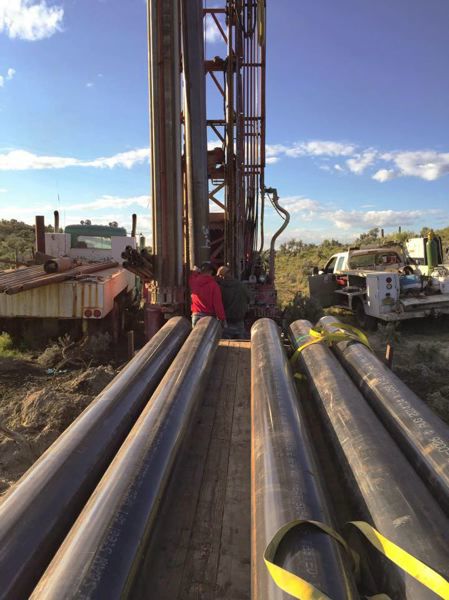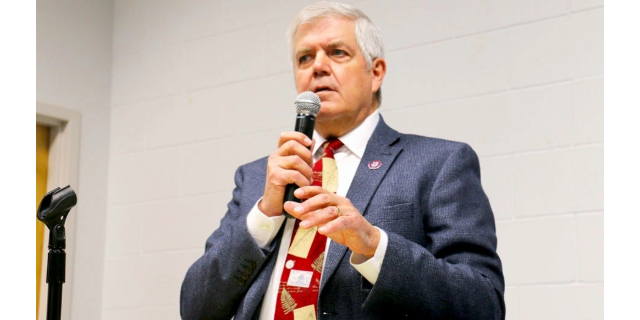Oregon plays catch-up on overseeing wells across state
Published 8:00 am Thursday, February 27, 2020

- BRAD WILLIAMS WELL SERVICE - A water well site under construction
Brad Williams of Terrebonne, Ore., recalls that at age 12, he started helping his dad, a water well driller, with construction projects: lugging tools, shoveling mud, “being the grunt.”
At 22, he got his well constructor’s license. At 53, in October 2019, the Oregon Water Resources Department revoked his license and fined him $7,550 for a string of civil violations.
“They don’t have the right to tell me I can’t work,” Williams said on Feb. 21. “I’m going to write them a letter saying I no longer recognize their authority. They can’t prevent me from standing on that drill rig and digging a hole right in their own backyard.”
Oregon’s water well infrastructure is a messy and misunderstood system — one that impacts agriculture, the environment and people’s drinking water. Oregon has meticulously choreographed programs for establishing and monitoring wells.
But across the state, wells are deteriorating, funding is sparse and the divide between bureaucrats and communities has provoked tensions over water.
Many wells, few resources
According to the National Groundwater Association, 70% of Oregon residents rely solely or partly on groundwater for drinking water. In rural areas, that grows to 90%. And approximately 24% of statewide irrigation supply comes from groundwater.
A well, which pulls water from an aquifer — typically an underground layer of water-bearing permeable rock — is a necessary tool.
Well drilling is a big industry. According to OWRD’s database, there are approximately 250,000 wells in Oregon today, not counting many drilled prior to 1955, when the Oregon Groundwater Act created basic well construction standards and established a database. About 3,100 new wells are drilled in the state each year.
Oregon’s hundreds of thousands of wells need inspection. Yet because of its limited budget, OWRD employs just five well inspectors statewide. Other staff, including watermasters and well compliance officers, may assist, and property owners can hire licensed drillers, but the bulk of inspection work falls on five individuals.
“The department does not have sufficient resources to inspect all wells,” said OWRD policy manager Racquel Rancier.
OWRD attempts to inspect 25% of new wells annually.
Dangerous defects
Older wells, especially those built before 1955 construction standards, are more likely to have problems, said Rancier. But new wells can be dangerous, too. About 11% of new wells constructed each year have at least one deficiency.
Deficiencies can be serious, in some cases threatening public health and safety.
For example, according to state Department of Environmental Quality archives, in 2002, residents of Dexter, Ore., complained of a strong gasoline odor in their water. DEQ investigated and found that improperly sealed wells near a former gas station served as a conduit for petroleum-contaminated drinking water.
In more recent cases, contamination has happened when wells were too close to septic tanks, drain fields or other toxic zones.
Improperly built wells, said Rancier, have also led to other environmental problems, groundwater level declines and loss of pressure.
In many parts of Oregon, aquifers are a shared resource. One failed well can impact an entire area.
In Mosier, Ore., according to OWRD, poorly constructed wells have caused groundwater levels to plummet 150 feet, resulting in dry wells and jeopardizing water supplies for homes, farms and communities. The Oregon Legislature invested $1 million in fixing or replacing Mosier wells. But, Rancier said, “other wells that do not meet construction standards” remain across Oregon.
When drilling doesn’t go well
On Oct. 30, 2019, OWRD revoked Williams’ Water Well Constructor License and applied civil penalties for multiple violations. According to the department, he had allegedly misstated facts on a well report and had failed to file paperwork, communicate with the department and pay required fees.
“I didn’t misstate anything intentionally,” said Williams. “If the department wanted to check the seals for themselves, they should’ve been on site with me with a core drill and probe.”
Williams expressed frustration because he was accused of misstating seal details, but no inspector was on site when he sealed the wells. The OWRD case file shows that Williams’ wells were inspected much later: 7, 8, 10, 11 and 29 months after construction, respectively. Rancier said the wells could not be inspected immediately due to access issues.
Seals are crucial to protecting against contamination, destruction of aquifers and other dangers. Oregon’s standards provide different sealing requirements based on geological formations. Within the Columbia River Basalts, for example, a well may need to be cased and sealed hundreds of feet, while a gravel-based domestic well may only need to be sealed to 18 feet.
Since his Oregon license was revoked, Williams said he has been drilling in California.
According to Lauren Bisnett, information officer for California Department of Water Resources, California has a patchwork of rules in which local permitting agencies govern well standards.
In some California counties, on-site inspection during construction is required. But according to OWRD, that’s not yet feasible in Oregon because of limited staff and because drillers are permitted to give notice right up to the day of construction, too late for inspectors to respond.
Lost in paperwork
Williams blames his license revocation on the nature of his job — rugged work that often involves being on the road.
Williams said he has no office, no computer, no fax machine and lives in his truck half the time. His paperwork, he said, is stuffed in a briefcase on the backseat of his pickup.
“It’s physically impossible for me to make a living drilling and keep chasing my paperwork at the same time,” said Williams.
OWRD, which also deals with loads of paperwork, waited three months, until January 2020, to release a statement about Williams’ civil penalties.
“I’m not saying I’m without fault,” said Williams. “But the water department said their workload was heavy. What about my workload?”
The paperwork required of drillers, explained Rancier, is crucial to keeping wells safe and well-monitored. But in a twist of irony, OWRD’s small staff has time to review only 10% of well logs.
Trouble for landowners
If inspecting wells is hard, financing them is harder. Some reconstruction work — even abandonment — can cost tens to hundreds of thousands of dollars, said Rancier.
A well driller who fails to meet standards is financially responsible. But if a well is damaged by aging, natural disaster or lack of maintenance, the landowner is responsible.
Many landowners lack the financial resources to fix their wells, and OWRD does not have funds for repairing or abandoning non-compliant wells.
Peter Mohr, a natural resources attorney, said he gets numerous calls from landowners who know little to nothing about their wells.
Farmers who inherit land, said Mohr, don’t always know the historic water well use for their property; those who buy land often don’t grasp the well situation.
“And (real estate agents) don’t know jack about water rights,” said Mohr.
The fact that many landowners can’t afford well repairs means farmers and drillers often have a strained relationship.
“Farmers are the ones who always give me trouble,” said Williams. He recounted cases of drilling wells without getting paid. “It’s not their fault. If the well isn’t done, they can’t put water on the ground. But then they can’t pay until harvest or later, sometimes never.”
Paying for well repairs, said Willaims, has bankrupted some landowners.
Improving the system
Rancier said OWRD is working on a strategic plan to improve Oregon’s struggling well infrastructure.
“I’ve had a rough career,” said Williams. “I’m a repeat offender, and I own my part of that. But it’s plain to see we need a better system.”





